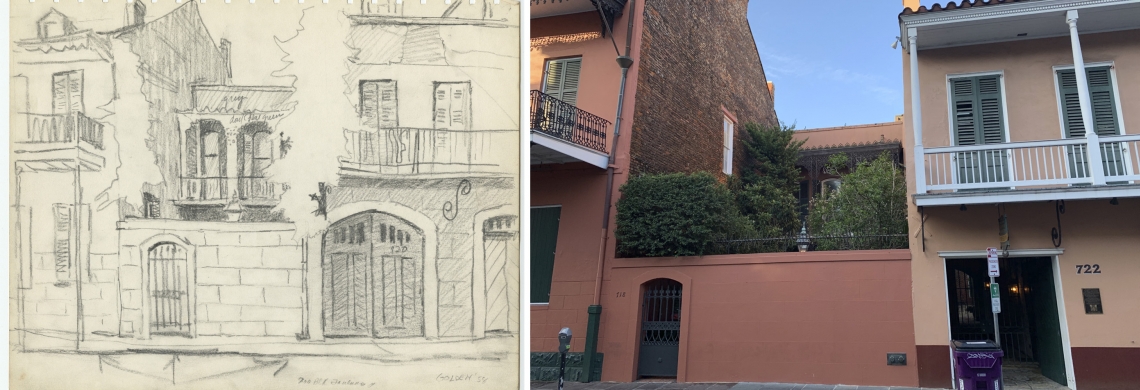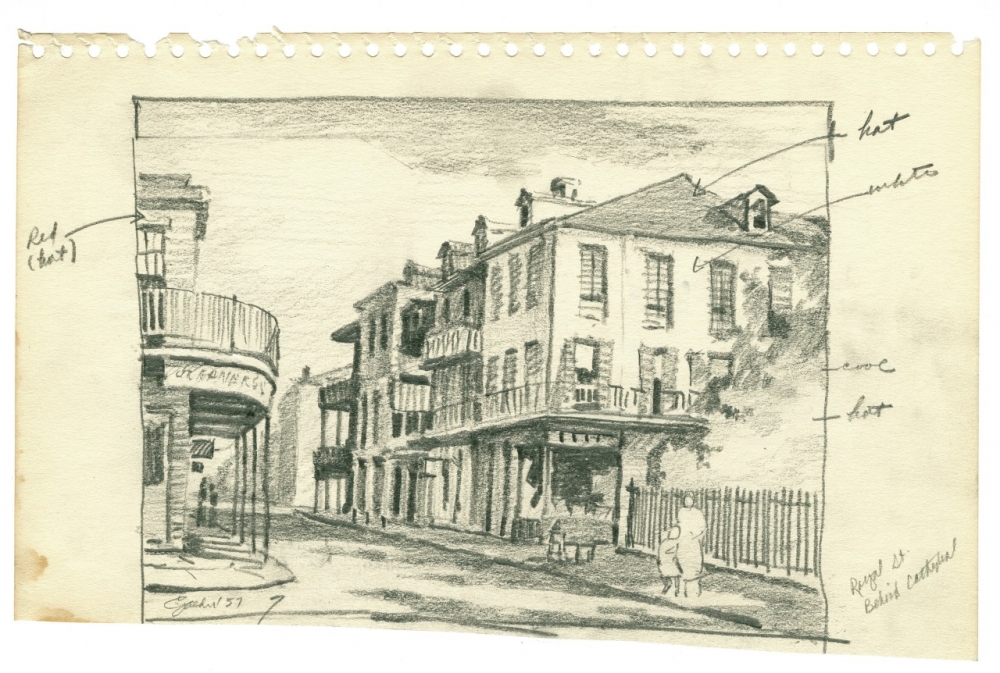Born in New Orleans in 1931, Rolland Golden—who passed away in July 2019—spent much of his career as an artist drawing and painting Southern scenes. After serving in the Navy, Golden attended the John McCrady Art School from 1955 to 1957. Those years studying in the French Quarter began a lifelong love for the old buildings and charm of the Vieux Carré. After graduation, Golden married Stella Doussan and opened the Patio Art Studio on Royal Street. In the next few years, and as their family grew to include three children, they moved between several apartments on St. Philip, Royal, St. Ann, and Bourbon Streets—all in the French Quarter.
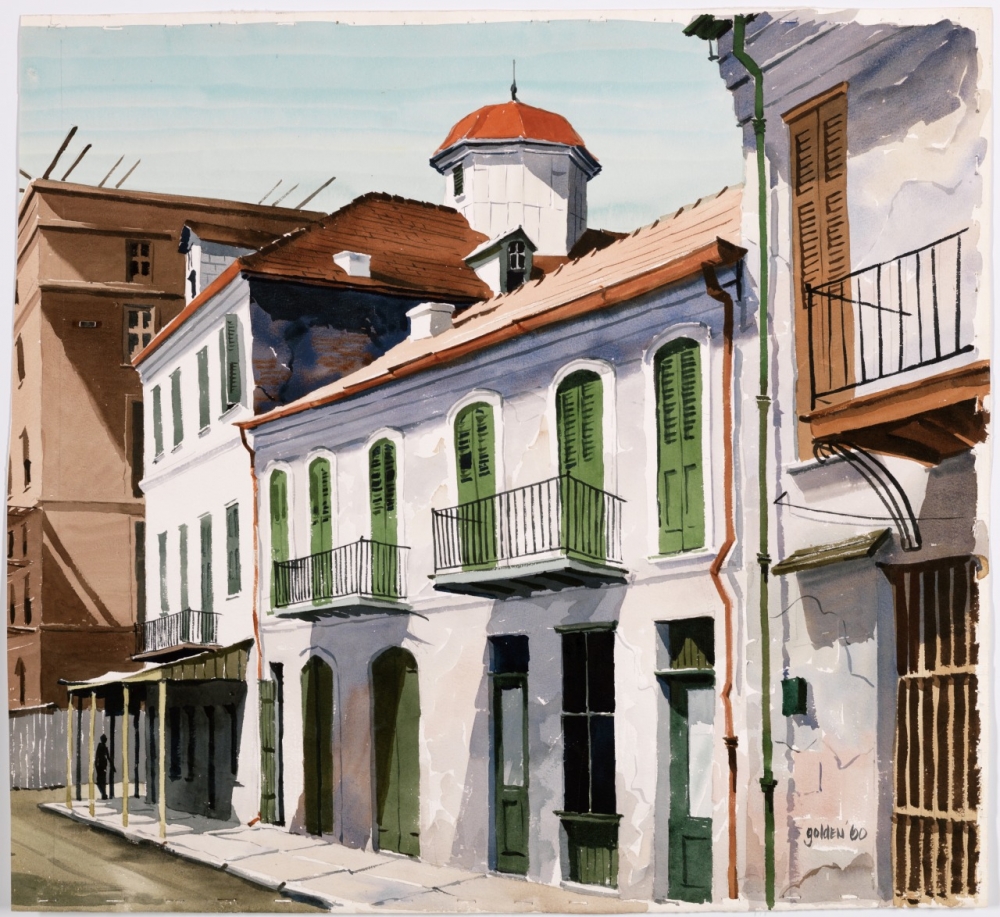
Golden completed this painting of the Napoleon House in 1960. During this time, the artist was skteching areas around the French Quarter, some of which have changed greatly since his work, some which have stayed relatively the same. (THNOC, 1975.130)
By the early 1960s the French Quarter was undergoing a shift from a quaint residential neighborhood to a bustling tourist destination. Local residents feared that the charm and architecture that drew them to the historic district was being eroded by its own popularity, as large hotels and new commercial buildings began to alter the character of the neighborhood. Organizations such as the Vieux Carré Commission, established in the 1930s, and the Louisiana Landmarks Society, founded in 1950, sought to preserve the historic neighborhood. In 1961 the preservation movement found a voice in the Vieux Carré Courier, which began publishing as a weekly newspaper reporting on issues specific to the preservation of the French Quarter.
From the outset, the paper commissioned Golden to create two to three drawings a month for the column titled “Along the Banquette,” by Edith Long. With this commission, his role in the historic preservation of the French Quarter commenced. Many of Golden’s works from the 1950s and 1960s depict a changing French Quarter, often with a focus on the minute and seemingly ordinary details of everyday life. Below, we’ve presented a selection of sketches, some matched with modern photographs, to see how Golden’s French Quarter has changed—and stayed the same.
1. 600 block Dumaine, 1962
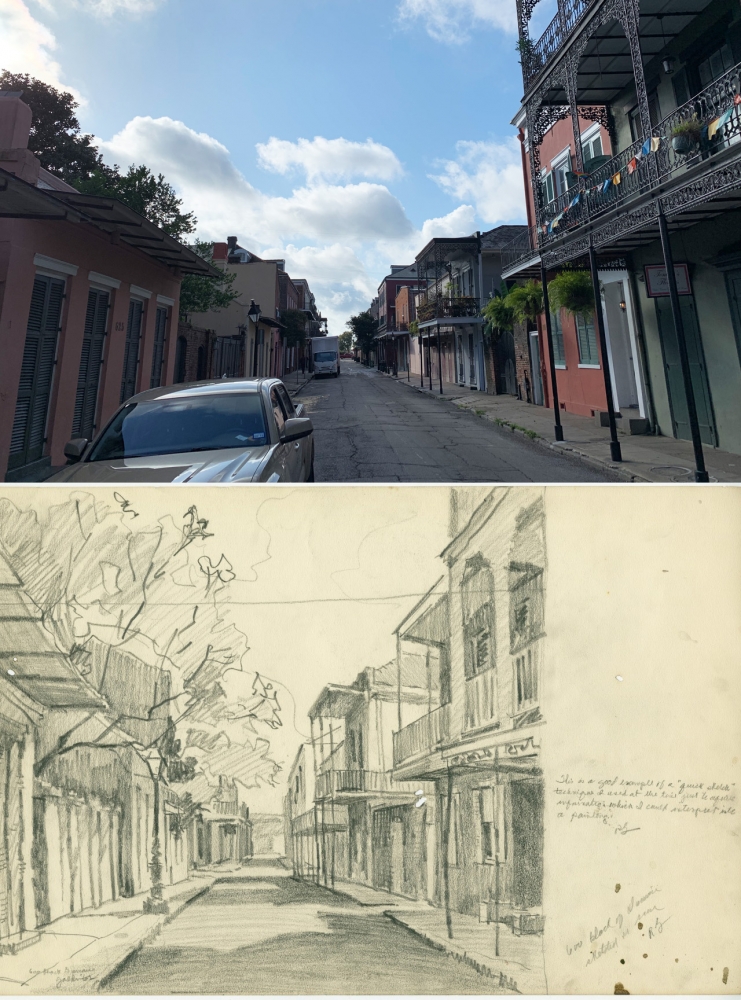
View of Dumaine Street, looking toward the Mississippi River. In the right margin Golden later noted, “This is a good example of a ‘quick sketch’ technique I used at the time just to acquire information which I could interpret into a painting.” (THNOC, 2011.0430.80)
2. 500 block of Iberville Street, looking toward Canal, 1958
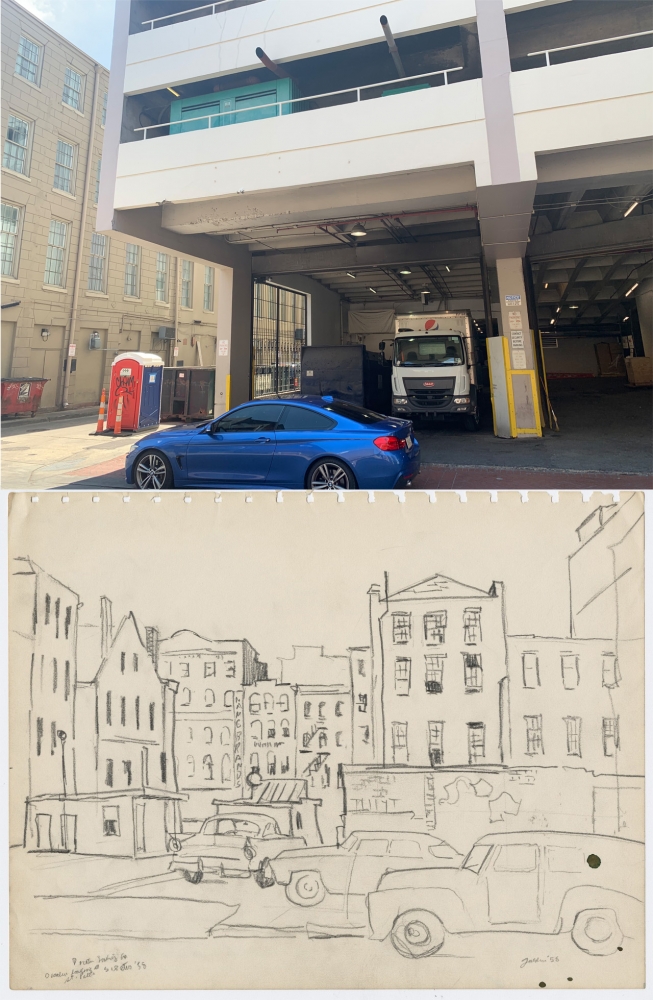
Looking toward the 500 block of Canal Street from a parking lot off of Iberville Street at Dorsiere Street (where the Marriott Hotel now stands). The three-story building on the middle left is the side view of 501–505 Canal Street and the buildings on the far right show the rear facades of 519–525 Canal Street. This glimpse into the past offers a view that was destroyed in the name of progress as the tourism industry expanded in the 1950s and 1960s. (THNOC, 2011.0430.185)
3. Decatur and Wilkinson, 1961
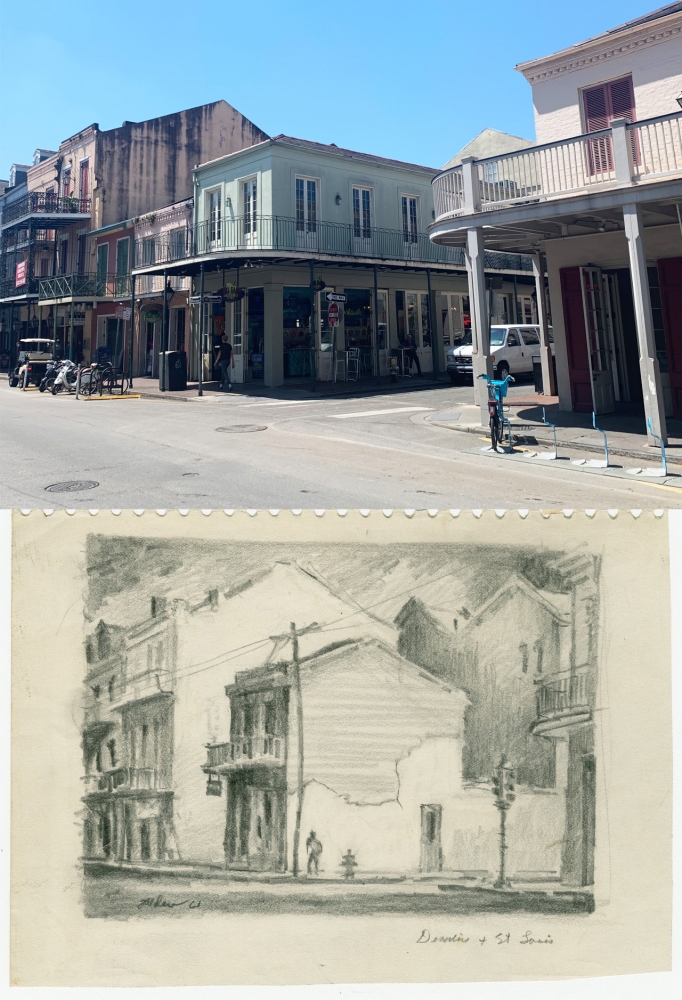
Drawing of the corner of Decatur and Wilkinson Streets. In the center, the two-story brick building at 615 Decatur stands next to a vacant lot. Today a late 20th-century commercial building stands on the corner. Golden added the note, “Decatur & St. Louis,” at a later date but based on the buildings in the drawing, he identified the wrong location. (THNOC, 2011.0430.112)
4. Patio behind Preservation Hall, 1958
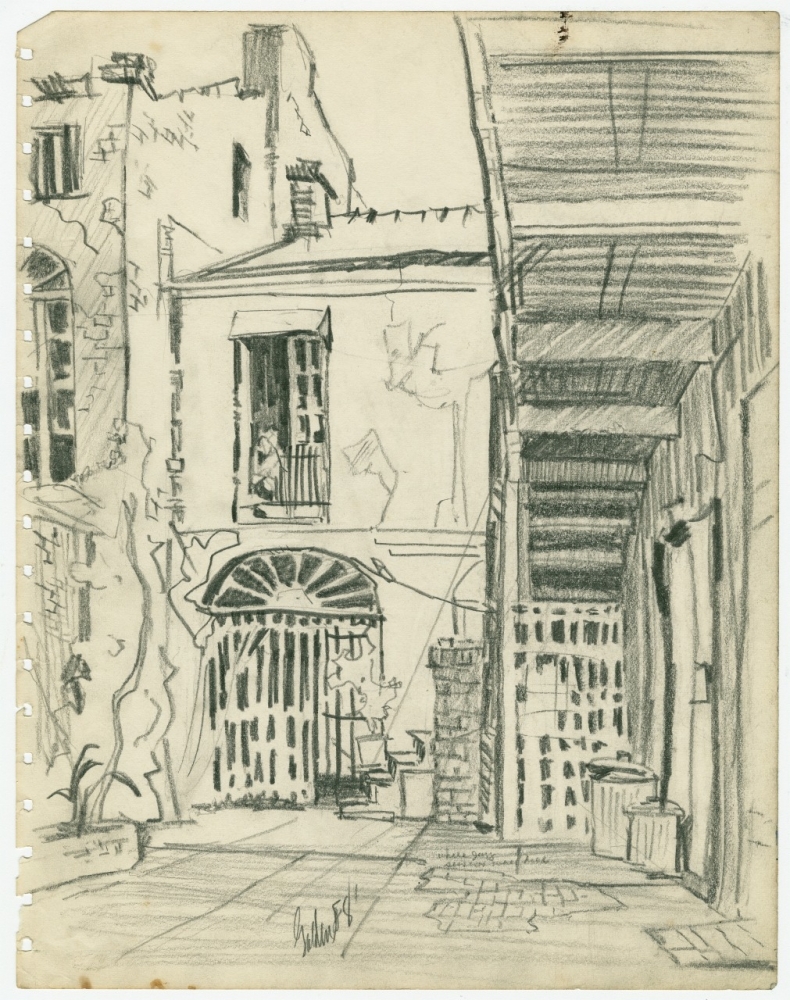
Drawing of the courtyard behind Preservation Hall. On the left is the gate that leads to St. Peter Street, and on the right is the underside of a balcony. Golden often focused on mundane objects such as the trash cans beneath the balcony. In his autobiography, Rolland Golden: Life, Love, and Art in the French Quarter, Golden wrote, “I liked to paint things that had been used over a long period of time… wasn’t interested in brand new or slick subjects, because they had yet to develop any distinction from other new and slick things. I liked old buildings where human beings had lived…and still lived; I liked old facades and doors with texture and wear and tear. I liked rutted roads…dilapidated barns, and fence posts with rusty wire attached” (p. 115). (THNOC, 2011.0430.22)
5. Decatur and North Peters, 1958
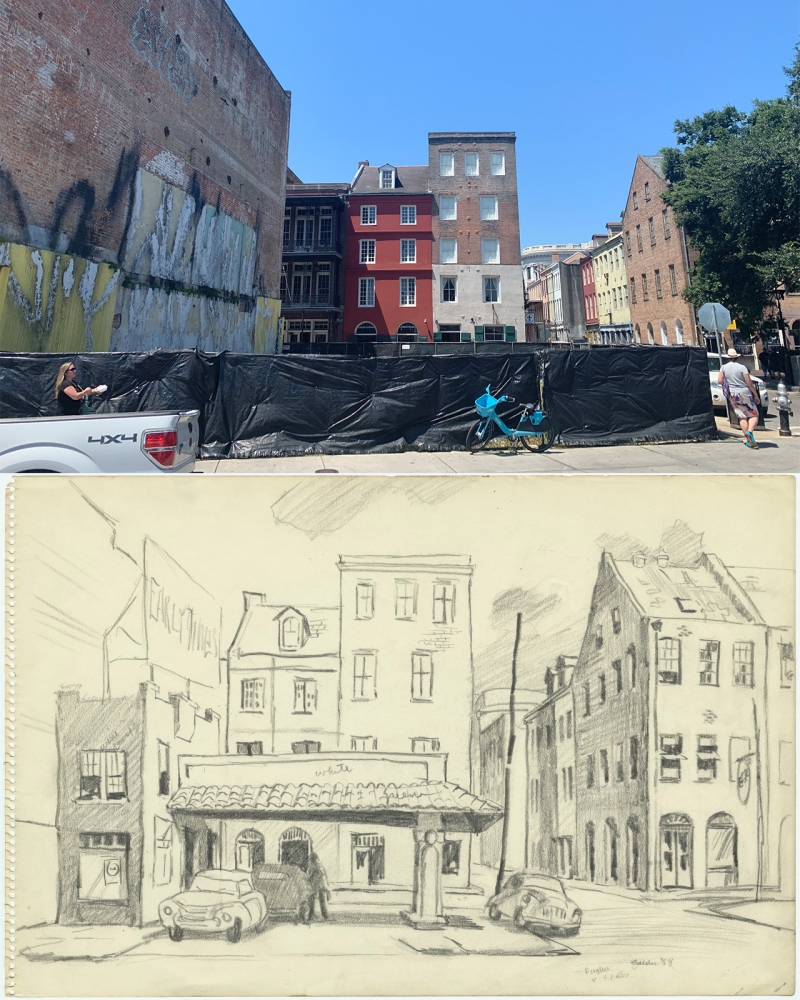
Drawing of the gas station that once stood on Conti Street between N. Peters and Decatur. The service station has been demolished and is now vacant; the two-story outline of its building remains, covered in graffiti. (THNOC, 2011.0430.189)
6. Dumaine Street; Royal Street behind cathedral, 1964
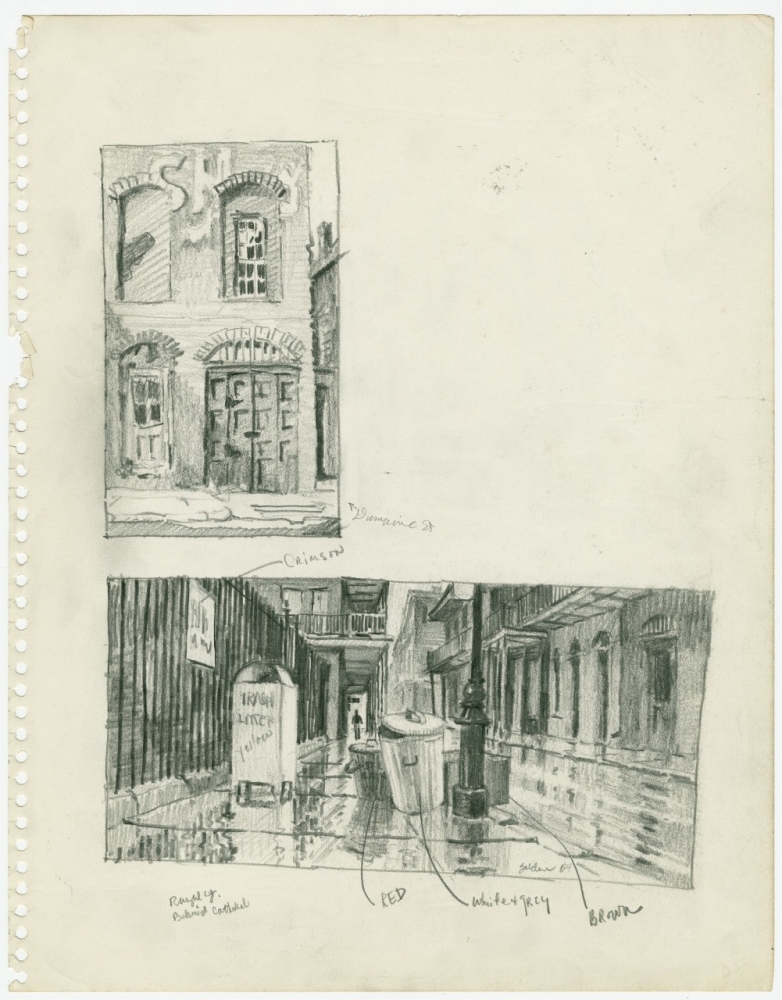
The top drawing shows a partial view of a building’s facade on Dumaine Street. The bottom drawing shows the 700 block of Royal Street, just behind the St. Louis Cathedral. In the center are several different types and sizes of trash cans. Notes about color are written on the drawing, and the street and sidewalk appear to be wet. (THNOC, 2011.0430.115)
7. Bourbon and Toulouse, 1957–1965
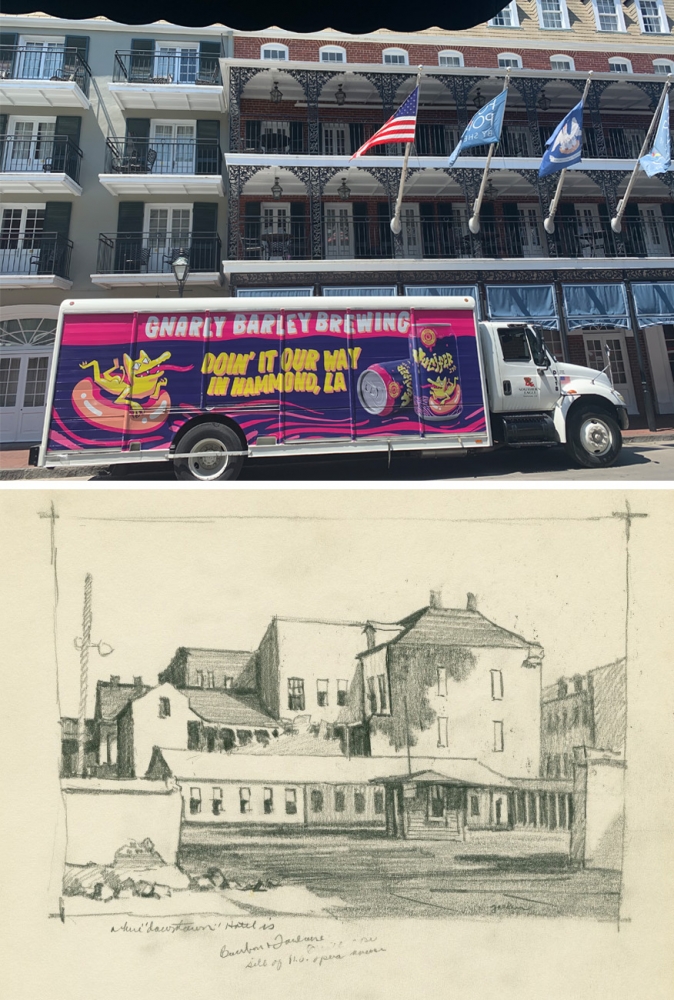
Drawing of a lot at the corner of Bourbon and Toulouse Streets, the site of the old French Opera House, which burned down in 1919. The lot sat vacant until a hotel—now the Four Points by Sheraton—was built in 1965. (THNOC, 2011.0430.8)
8. Madame John’s Legacy, 1962
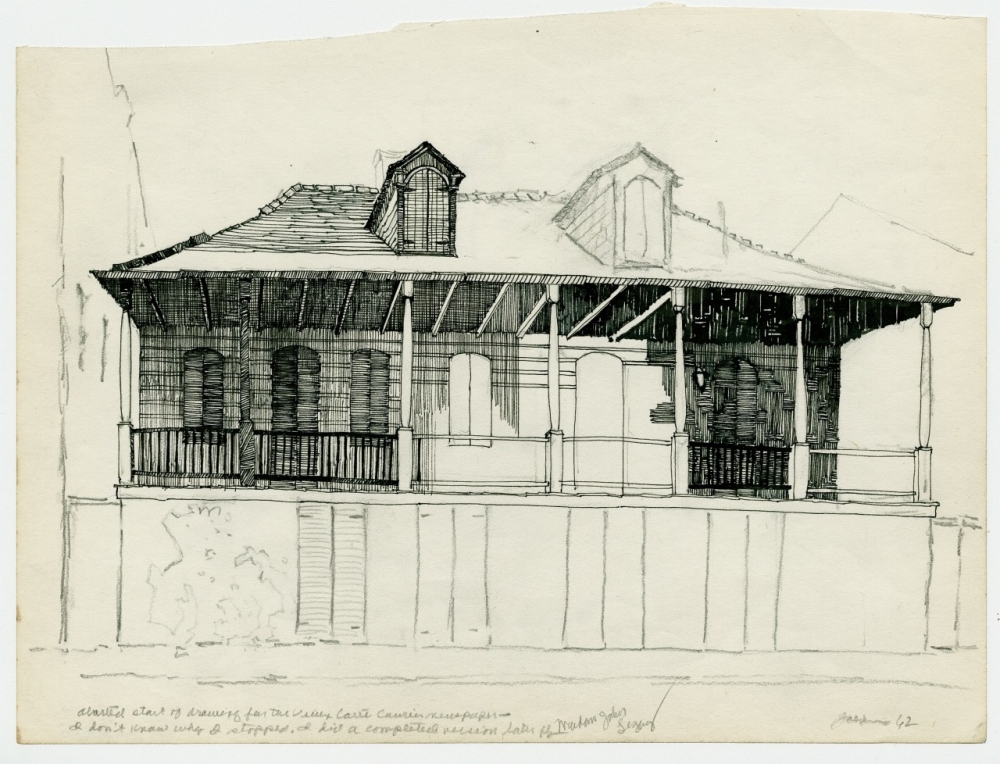
Incomplete drawing of the facade of Madame John’s Legacy on Dumaine Street. Golden noted at the bottom that the initial drawing was for the Vieux Carré Courier newspaper, but he didn’t complete it; Golden made another version at a later date. (THNOC, 2011.0430.40)
9. Esplanade, 1958
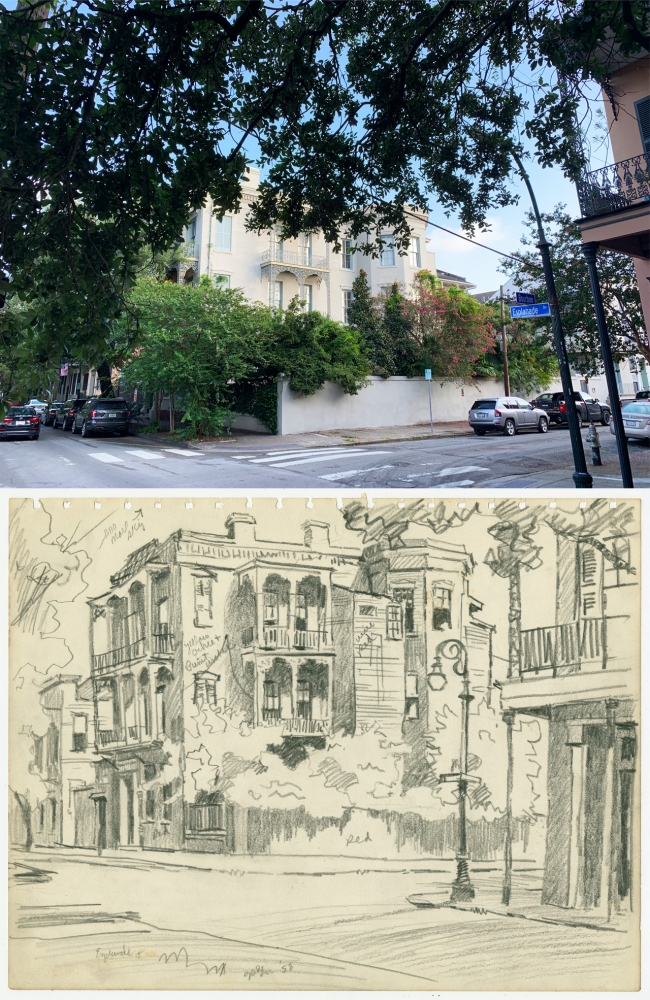
Drawing of the intersection of Esplanade Avenue and Bourbon Street. The three-story mansion at 807 Esplanade sits in the center of the drawing. In his quick sketches, Golden often included notes about color, as he does here by noting the “yellow ochre” on the house and the “wine red” of the wall. (THNOC, 2011.0430.117)
10. Destroyed house on Burgundy Street, 1957–1965
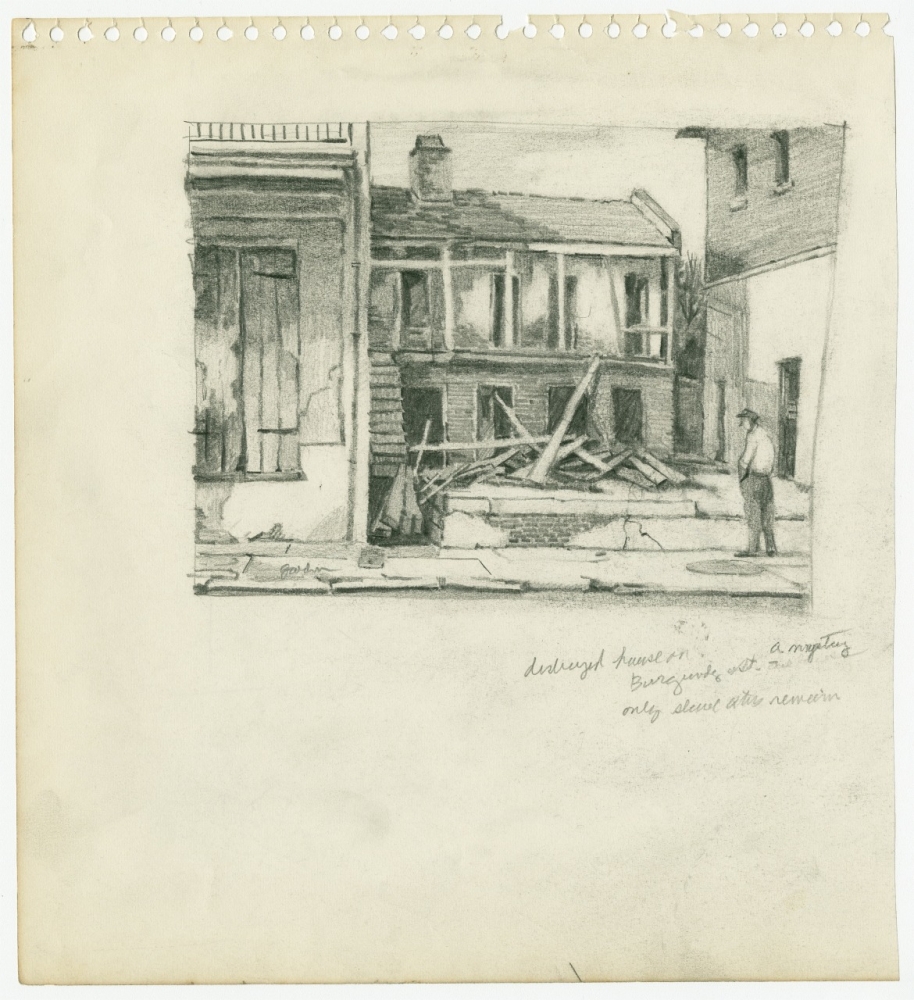
Drawing of debris cluttering a lot on Burgundy Street. Buildings still stand on three sides of the lot. A note at the bottom describes the sight as “a mystery” and mentions that only the slave quarters remained. (THNOC, 2011.0430.114)
11. Site of Regal Brewery after demolition, ca. 1965
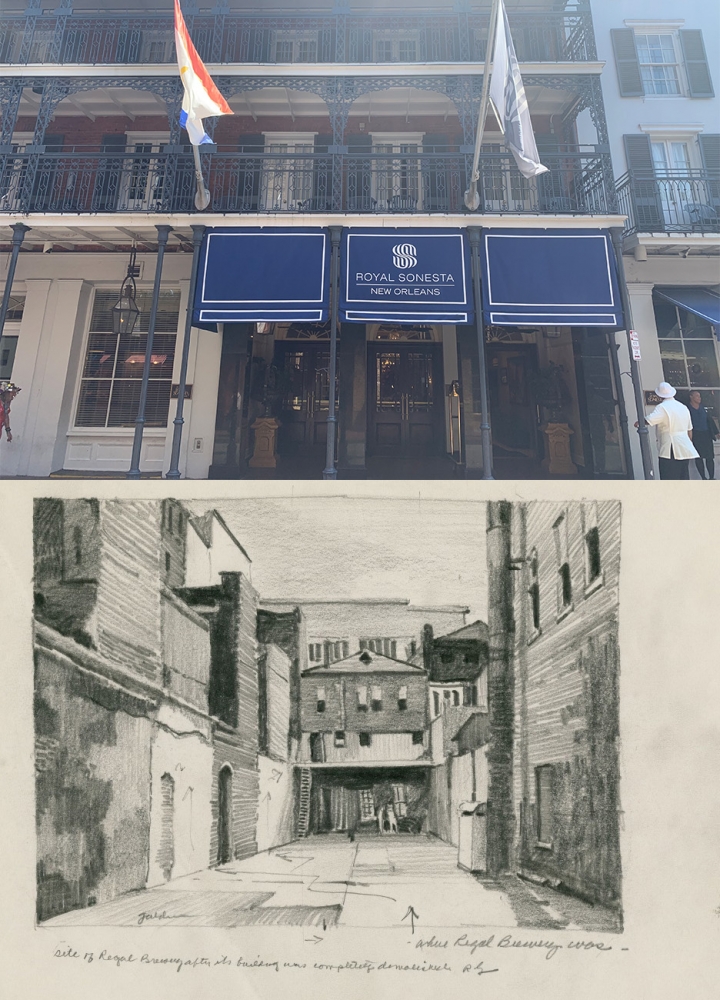
View of the lot on the 300 block of Bourbon and 700 block of Conti Street, where the Regal Brewery stood. The brewery, as well as the other buildings in this sketch, was torn down in 1964 for the construction of the Royal Sonesta Hotel. (THNOC, 2011.0430.166)
12. House on St. Louis Street, 1965
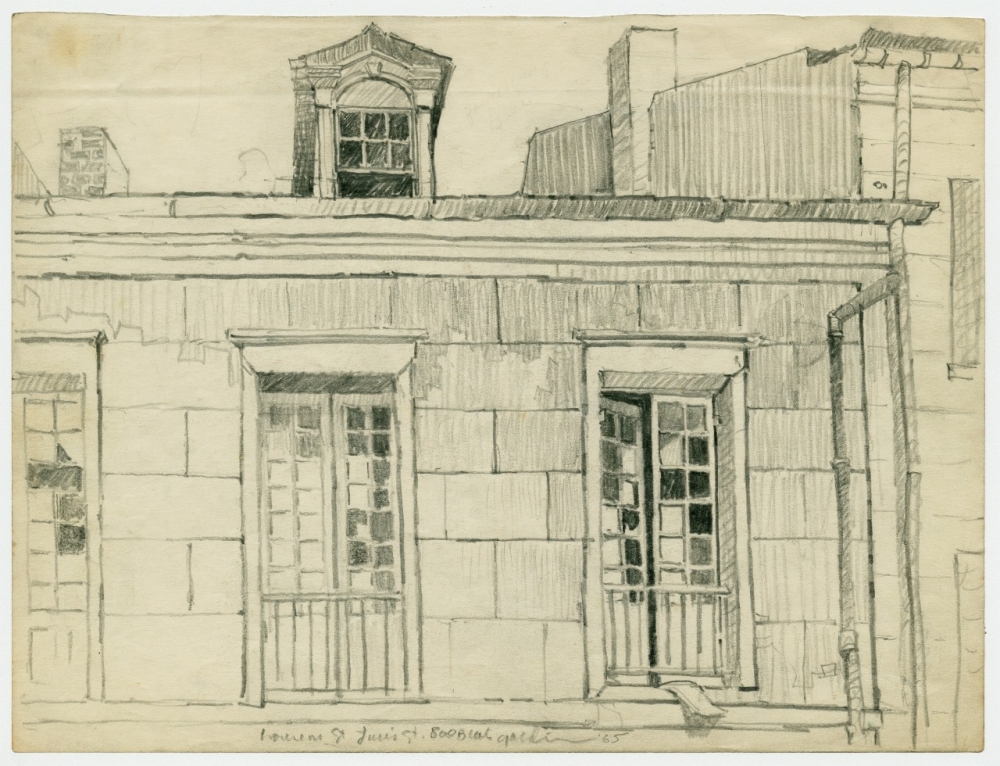
Partial view of the facade and roofline of 528–530 St. Louis Street. In the early 1960s, Golden traded a painting for a camera and would wander through the French Quarter, taking pictures of buildings. He said in his autobiography that he was drawn to “peeling facades, crooked doors with cracked glass, shutters with louvers missing, almost anything that looked old or worn and bore signs of old age” (p. 64). (THNOC, 2011.0430.55)
13. Gov. Nicholls Street, 1958
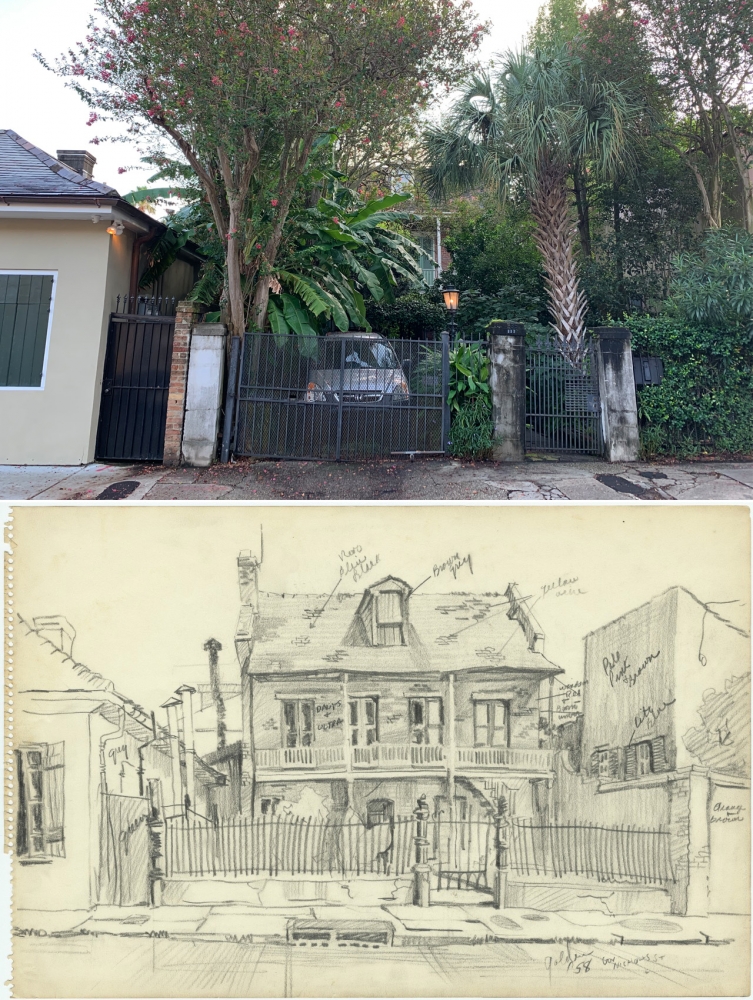
Drawing of the two-story house at 835–837 Governor Nicholls Street. Colors are noted in pencil throughout the drawing. (THNOC, 2011.0430.176)
14. 700 block Toulouse, 1958
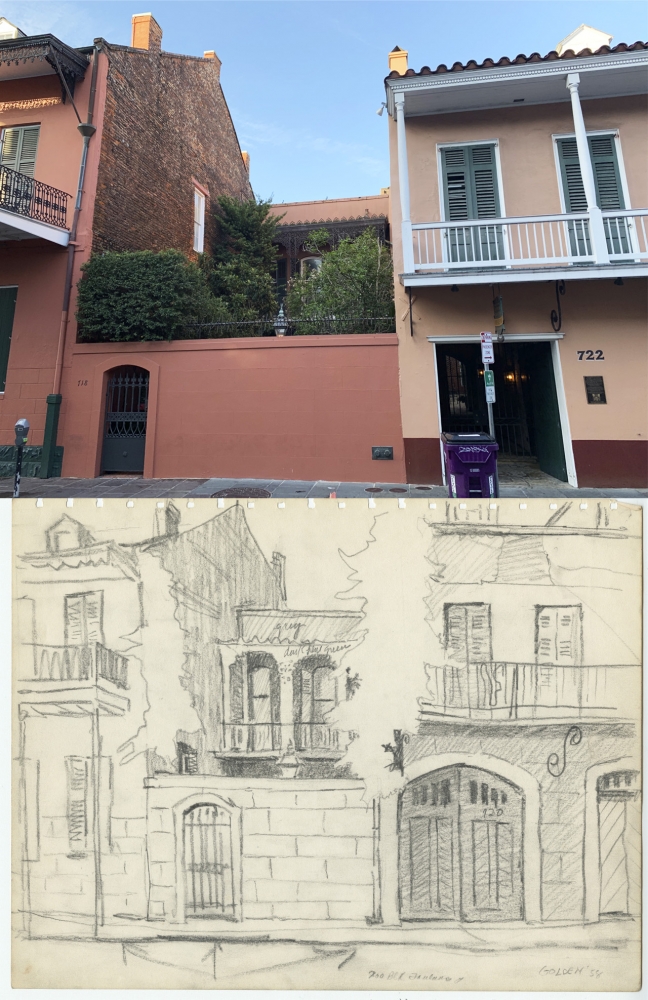
Drawing of the residence at 718 Toulouse Street, which at the time was home to THNOC’s founders General Kemper and Leila Williams, with a partial view of the Louis Adam House at 722 Toulouse Street. Most of Golden’s architectural drawings do not include people, instead focusing primarily on the structures. He wrote in his autobiography that he “decided, except in certain cases, that placing people—for example, persons walking down Royal Street—made the painting look less serious and took the viewer’s eye off the architecture, which was my reason for producing the painting” (p. 73). (THNOC, 2011.0430.175)
15. 600 block Toulouse, 1963
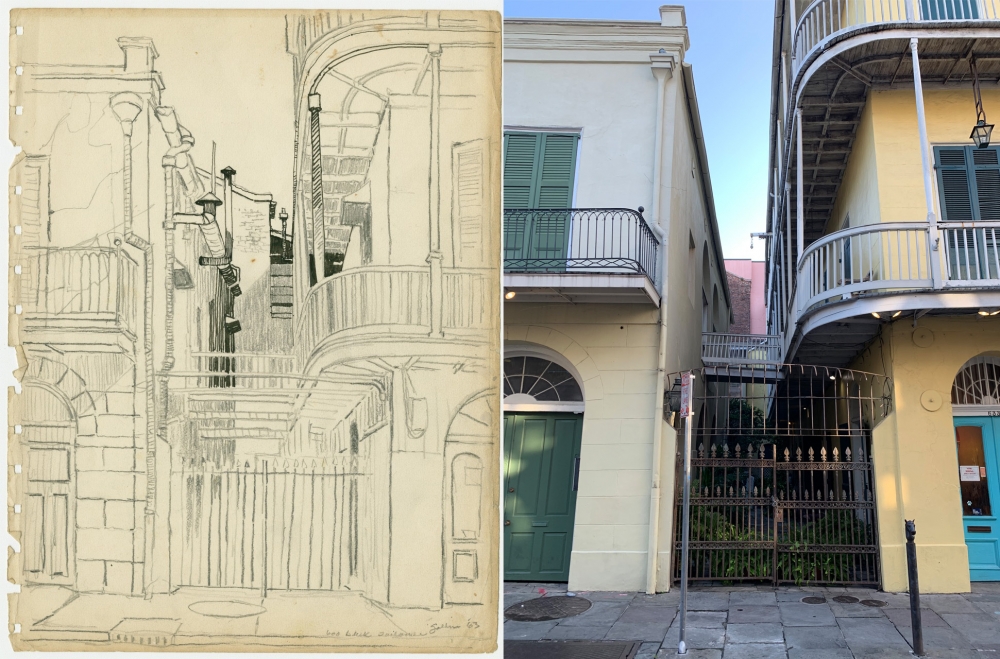
Drawing of a gate on the 600 block of Toulouse Street. Both buildings on either side of the gate are partially visible: the two-story building at 635 Toulouse and three-story building at 633 Toulouse. (THNOC, 2011.0430.37)
16. Royal Street behind Cathedral, 1957
Drawing of Royal Street at the intersection of Orleans. A woman and child are outlined in front of the gate that leads to the garden behind the St. Louis Cathedral. Notes about “hot” and “cool” colors are written around the drawing. (THNOC, 2011.0430.86)
17. Bourbon Street, 1958
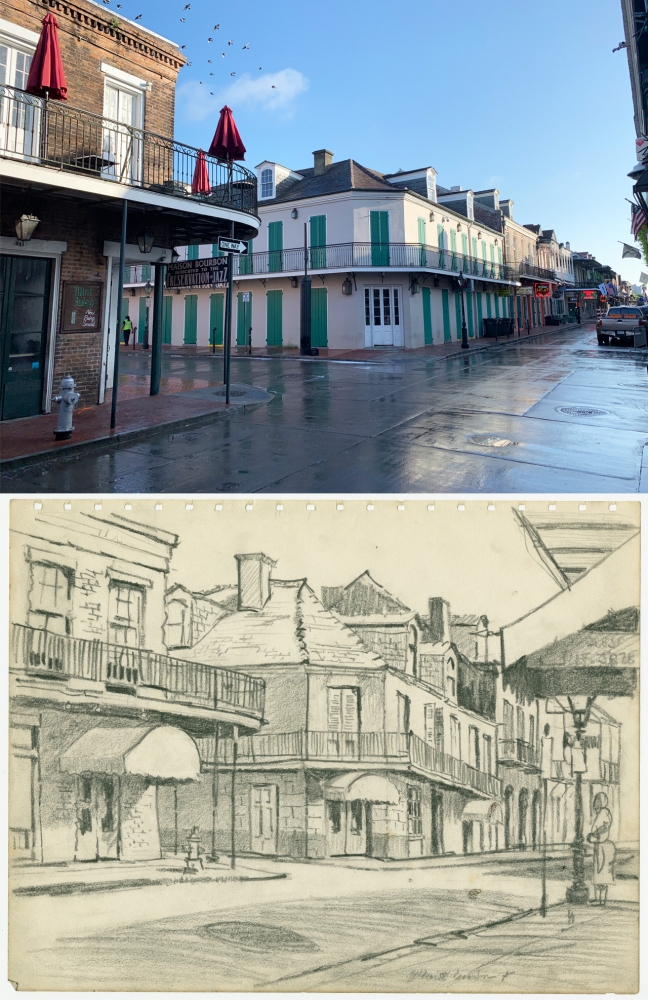
Drawing of the intersection of Bourbon Street and St. Peter Street. Golden placed the outline of a female figure standing beneath a street lamp on the right. He said that when he did include people in his drawings, he kept them from being the emphasis by putting them in the distance or by choice of color or technique. (THNOC, 2011.0430.122)
These sketches are available to reserachers at THNOC's Williams Research Center, 410 Chartres Street. The WRC is free and open to the public, and walk-ins are welcome.

